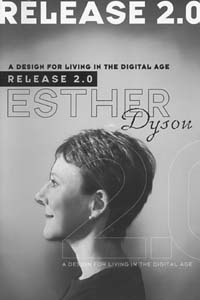Browsing the Future
Esther Dyson sees the digital future through a rose-colored screen saver
By Jenn Shreve
IN THE AGE OF APPLIANCES, banks gave away toasters to lure in new accounts; these days, car dealers are offering Web-TV terminals as come-ons. In an era when even family pets have their own Web sites, it's easy to forget that not everybody is plugged into the Internet. For that matter, most of the world doesn't even own a computer. But that gap between hype and reality doesn't hamper cyber-sayer Esther Dyson from envisioning a world of wired people all linked together in digital community and commerce.
In Release 2.0: A Design for Living in the Digital Age, Dyson, one of the Internet's only "big thinkers," explores the theoretical and philosophical questions that have arisen as a result of the new communications technology. And she does so with the thoroughness and knowledge of someone who's been studying and writing about (not to mention investing in) high-tech industries for more than two decades. Her speculations are solidly grounded by her reputation as editor, publisher and author of Release 1.0, a pricey, influential industry-insider newsletter.
Since its introduction into the mass marketplace in the early '90s, the Internet has transformed communication, commerce and the international job market. Email has made it easy to communicate globally; the World Wide Web enables anyone and everyone with a modem and phone line to publish and be read by potential millions; complete strangers can now do business, consult with one another, create activist movements and build friendships from the solitude of their desktops.
That's hardly news, but it does inspire Dyson to an idyllic vision of the future. For her, the Internet is the tool with which average people can change the world--both locally and globally--through the public airing of opinion and fact and through a market-based form of self-governance. Optimistically, Dyson believes that free of outside interference the Internet's oft-cited problems of censorship, security, encryption and privacy will eventually be resolved internally by a community of Internet users through the power of the dollar.
She is certainly right about the influence of money, although not necessarily about it source. Dollars will dominate what users find in their browser windows, but they won't be the dollars of community members.
Instead, large corporate interests will strike deals with the richest content providers, making their products the easiest and most obvious to access; advertising revenue will reward content deemed acceptable and noncontroversial to a mass audience.
Just capitalism at work, but Dyson for the most part overlooks this aspect of the Internet, choosing instead to focus on micro-issues: individual users fighting spam in their inboxes or blocking out pornography. For a high-tech investor and reporter who worked as a securities analyst on Wall Street, that's a fairly major oversight.
Esther Dyson biographical info.
LIKE MANY Internet activists, Dyson is an unapologetic libertarian. For her, the true importance of the Internet is its potential to empower individuals against the forces of government. The dispersed nature of the World Wide Web enables individuals (and businesses) to avoid physical jurisdiction, and the ability of users to communicate freely can foster a kind of free-market democracy that leans on the side of citizens, not legislators.
When Dyson isn't just barking furiously about power imbalances and theoretical human rights violations, she sounds less like a mad Cassandra and more like a sensible pundit balancing theory with reality.
On the issue of censorship, for instance, Dyson provides a useful discussion about the tools that are being designed to label content (something called PICS, Platform for Internet Content Selection) on the Web. She also provides an overview of the various filtering tools (such as CYBERsitter or Net Shepherd) that will allow consumers to customize their biases: family filters, Christian filters, animal rights filters, etc.
Whatever you make of Dyson's ideas and solutions, not to mention her prose--which reads like a leaden office memo--her emphasis on theoretical concerns is refreshing. Until now, most Internet books have focused on what sites are "coolest" and how to write html. Dyson prefers to look at the ways this technology can change our workplaces, our marketplaces and our communities. Unfortunately, she is not entirely sure what community she is addressing.
To understand Release 2.0, the reader must be more than averagely knowledgeable about the inner workings of the Internet--from the personal-user standpoint as well as the business and technical side. But Dyson's tone often implies that she's speaking to the neophyte user with a slow modem who just got email and is wondering if it's safe to order a plane ticket over the Internet. It's never clear.
Worse than not knowing her audience, Dyson totally overlooks the majority of the world--those without so much as electricity, not to mention a computer. She talks about a global marketplace and community, an ever-closer time when almost everyone will be online. But that's a cyber pipe dream.
We all want the world to be a better place, but oppressed peoples in the Congo aren't going to be equipped with T-1 lines and fighting ethnic cleansing with their Web pages any time soon. Inner-city school districts can't even afford good teachers much less laptops. Dyson's Internet community is indeed rapidly growing, but for now her observations are only relevant to a select few.
[ Metro | Metroactive Central | Archives ]
Copyright © Metro Publishing Inc. Maintained by Boulevards New Media.
![]()

The Future Is Now: At least that's what digital guru Esther Dyson thinks.

Release 2.0: A Design for Living in the Digital Age by Esther Dyson; Broadway Books; $25 cloth.
From the Dec. 18-24, 1997 issue of Metro.
![[Metroactive Books]](/books/gifs/books468.gif)